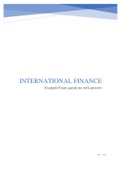Summary
Summary International Finance exam questions with answers
- Course
- Institution
This document contains some example exam questions with answers to know for the exam of the course International Finance. The document contains +- 40 questions.
[Show more]



